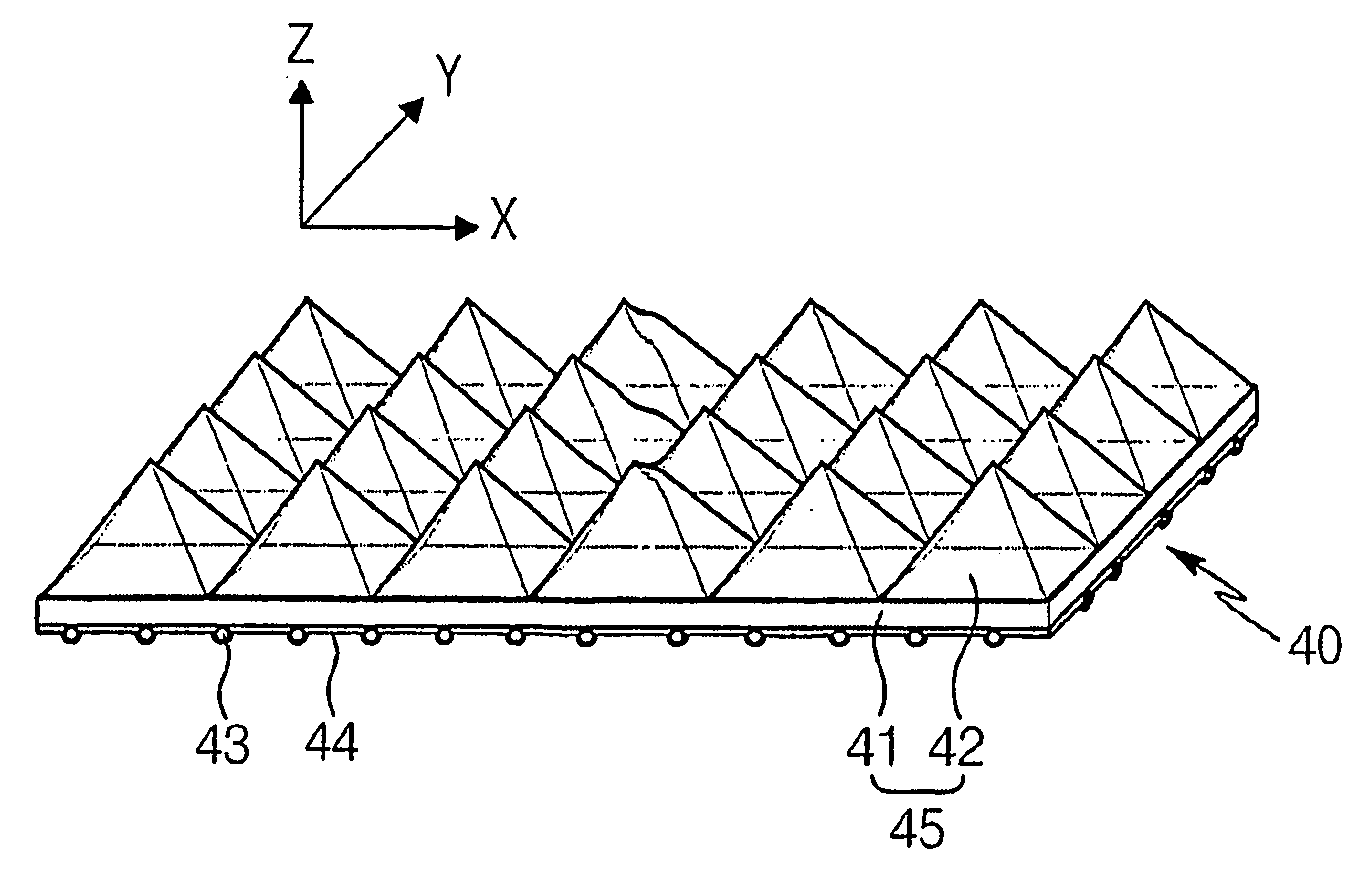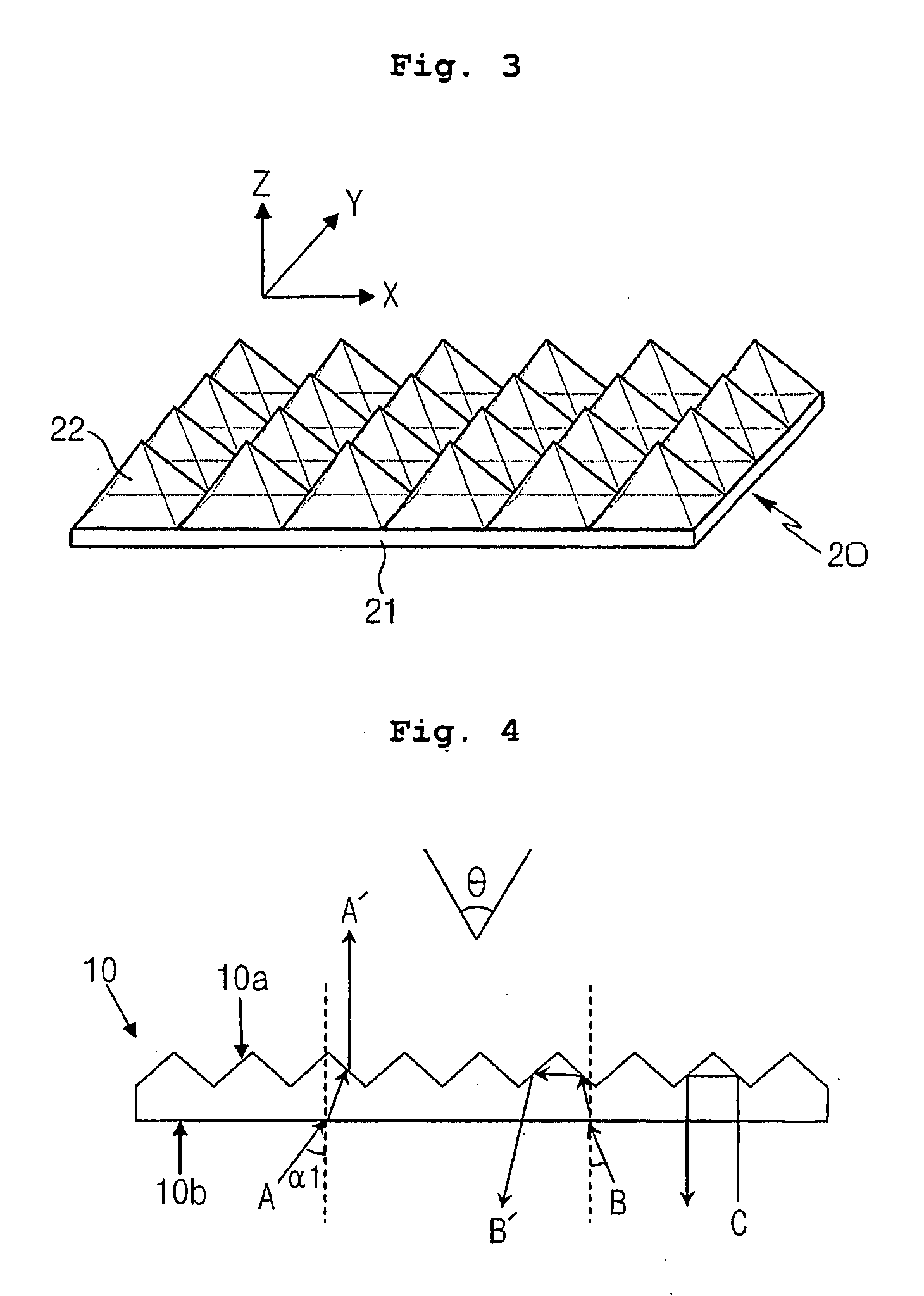Transparent Optical Film Comprising Damage Prevention Layer Having Particles Distributed Therein
a technology of optical film and damage prevention layer, which is applied in the field of optical film, can solve the problems of affecting so as to improve the quality of optical film, and prevent the attachment of impurities
- Summary
- Abstract
- Description
- Claims
- Application Information
AI Technical Summary
Benefits of technology
Problems solved by technology
Method used
Image
Examples
example 1
[0049]90 parts by weight of acrylic polyol and 10 parts by weight of isocyanate were dissolved in 300 parts by weight of methylethylketone and 200 parts by weight of toluene. 10 parts by weight of polymethylmethacrylate (PMMA) particles (average diameter 5 μm, monodispersed particles) and 2 parts by weight of quaternary amine-based antistatic agent were dispersed in the above solution. Subsequently, the obtained solution was applied on one surface of a 125 μm thick base film formed of polyethyleneterephthalate using gravure, and dried at 100° C. for 30. sec, to prepare a sheet including a damage prevention layer composed of 6 μm thick portions in which particles were distributed and 4 μm thick portions in which no particles were distributed.
[0050]A mixture of 95 parts by weight of an acryl-based UV curing resin and 5 parts by weight of a light initiator was applied on the surface opposite the damage prevention layer of the sheet, and exposed to UV, to manufacture an optical film hav...
example 2
[0051]90 parts by weight of acrylic polyol and 10 parts by weight of isocyanate were dissolved in 300 parts by weight of methylethylketone and 200 parts by weight of toluene. 20 parts by weight of PMMA particles (average diameter 5 μm, monodispersed particles) and 2 parts by weight of quaternary amine-based antistatic agent were dispersed in the above solution. The subsequent processes were performed in the same manner as in Example 1, to manufacture an optical film.
example 3
[0052]90 parts by weight of acrylic polyol and 10 parts by weight of isocyanate were dissolved in 300 parts by weight of methylethylketone and 200 parts by weight of toluene. 20 parts by weight of PMMA particles (average diameter 5 μm, monodispersed particles) and 2 parts by weight of quaternary amine-based antistatic agent were dispersed in the above solution.
[0053]Subsequently, unlike Example 1, the obtained solution was applied on one surface of a 125 μm thick base film formed of polyethyleneterephthalate using gravure, and dried at 100° C. for 30 sec, to prepare a sheet including a damage prevention layer composed of 6 μm thick portions in which particles were distributed and 2 μm thick portions in which no particles were distributed. In addition, on the surface opposite the damage prevention layer of the sheet, a mixture of 95 parts by weight of an acryl-based UV curing resin and 5 parts by weight of a light initiator was applied, and exposed to UV, to manufacture an optical fi...
PUM
 Login to View More
Login to View More Abstract
Description
Claims
Application Information
 Login to View More
Login to View More - R&D
- Intellectual Property
- Life Sciences
- Materials
- Tech Scout
- Unparalleled Data Quality
- Higher Quality Content
- 60% Fewer Hallucinations
Browse by: Latest US Patents, China's latest patents, Technical Efficacy Thesaurus, Application Domain, Technology Topic, Popular Technical Reports.
© 2025 PatSnap. All rights reserved.Legal|Privacy policy|Modern Slavery Act Transparency Statement|Sitemap|About US| Contact US: help@patsnap.com



